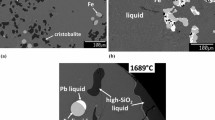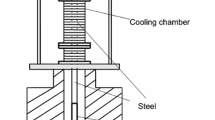Abstract
In view of the importance of the thermodynamic behavior of chromium in the slag phase as well as the serious discrepancies in the earlier reports on the valence state of chromium in slag melts, the oxidation state of chromium oxides in CaO-SiO2-CrOx and CaO-MgO-(FeO-) Al2O3-SiO2-CrOx were investigated experimentally in the present study using two different experimental techniques. The gas–slag equilibrium technique was adopted to study the CaO-SiO2-CrOx system between 1823 K (1550 °C) and 1923 K (1650 °C) and equilibrated with mixtures of CO-CO2-Ar gases corresponding to three different oxygen partial pressures (between 10−4 and 10−5 Pa). After equilibrating, the samples were quenched and subjected to analysis using the X-ray absorption near edge structure method to determine the distribution ratio of Cr2+/Cr3+ in the slags. The second technique examined the applicability of the high-temperature mass spectrometric method combined with the Knuden effusion cell for quantifying the valence states of Cr in the multicomponent system CaO-MgO-(FeO-) Al2O3-SiO2-CrOx up to a maximum temperature of 2000 K (1727 °C). The results showed that the Knudsen cell-mass spectrometric method could be used successfully to estimate the valence ratio for Cr in silicate melts. According to the present study, the Cr2+/Cr3+ ratio increased with increasing temperature and a decreasing slag basicity as well as the oxygen partial pressure prevailing in the system. A mathematical correlation of X CrO/X CrO1.5 as a function of temperature, oxygen partial pressure, and basicity was developed in the present work based on the present results as well as on those assessed from earlier data.









Similar content being viewed by others

References
M.G. Frohberg and K. Richter: Arch. Eisenbuttenwes., 1968, vol. 39, pp. 799–802.
H.D. Schreiber and L.A. Haskin: 7 th Proc. Lunar. Sci. Conf., 1976, pp. 1221–59.
W.J. Rankin and A.K. Biswas: Arch. Eisen huttenwes., 1979, vol. 50, pp. 7–11.
E.B. Pretorius, P. Snellgrove, and A. Muan: J. Am. Ceram. Soc., 1992, vol. 75, no. 6, pp. 1378–81.
E.B. Pretorius and A. Muan: J. Am. Ceram. Soc., 1992, vol. 75 (6), pp. 1364–77.
K. Morita, M. Mori, M. Guo, T. Ikagawa, and N. Sano: Steel Res. Int., 1999, vol. 70, pp. 319–24.
Y. Xiao and L. Holappa: ISIJ Int., 1993, vol. 33, no. 1, pp. 66–74.
W. Pei and O. Wijk: Scand. J. Metall., 1994, vol. 23, pp. 228–35.
A.J. Berry and H.St.C. O’Neill: Am. Mineral., 2004, vol. 89, pp. 790–98.
A.J. Berry, H.St.C. O’Neill, D.R. Scott, G.J. Foran, and J.M.G. Shellley: Am. Mineral., 2006, vol. 91, pp. 1901–08.
P.L. Dong, X.D. Wang, and S. Seetharaman: Steel Res. Int., 2009, vol. 80, no. 3, pp. 202–08.
L.J. Wang, V.L. Stolyarova, S.I. Lopatin, and S. Seetharaman: Rapid Commun. Mass Spectrom. 2009, vol. 23, pp. 2233–39.
V.A. Popov, S.I. Lopatin, L.S. Tsemekhman, L.A. Pavlinova, S.P. Kormilitsin, and V.V. Barsegyan: Rus. J. Appl. Chem., 2003, vol. 76, pp. 1606–08.
V.L. Stolyarova and G.A. Semenov: Mass Spectrometrica Study on the Vaporization of Oxide Systems, John Wiley & Sons, New York, NY, 1994.
S.R. Sutton, W. Jones, K.B. Gordon, M.L. Rivers. S. Bajt, and J.C. Smith: Geochim. Cosmochim. Acta, 1993, vol. 57, pp. 461–68.
V.P. Glushko, ed., Thermodynamic Properties of Individual Substances, Nauka, Moscow, Russia, 1990, pp. 1978–82.
N.Y. Toker: Ph.D. Dissertation, Pennsylvania State University, Philadelphia, PA, 1978.
E.T. Turkdogan: Physical Chemistry of High Temperature Technology, Academic Press, London, U.K., 1980, p. 10.
Acknowledgments
The authors are very grateful for the financial support from the Swedish Environmental Research Foundation (MISTRA No. 88032) as well as from the Outokumpu Research Foundation. The authors are extremely thankful to Professor M. Muhammed of the Royal Institute of Technology, Sweden and Professor T. Tzakalakos of Rutgers University, New Brunswick, NJ for their help with the XANES analysis as well as the valuable suggestions and strong support we received. Sincere thanks are extended to Professor V. Stolyarova of Sankt Petersburg State University, Russia for her help with Knudsen cell-mass spectrometric measurements. Valuable comments received on this report from Professor M. Hayashi of Tokyo Institute of Technology, Japan, Professor K. C. Mills from Imperial College, London, United Kingdom, Professor P. Taskinen from Helsinki University of Technology, Finland, and Professor V. Shatokha from the Ukrainian Metallurgical Academy are gratefully acknowledged.
Author information
Authors and Affiliations
Corresponding author
Additional information
Manuscript submitted September 28, 2009.
Appendix A
Appendix A
In regard to the reactions with respect to pure Cr2O3, three reactions are considered to occur, which would lead to the formation of the vapor species Cr, CrO, and CrO2, as shown in Eqs. [3] and [4]. Based on several measurements of pure Cr2O3, the ratio of the corresponding partial pressures of CrO2, CrO, and Cr is roughly about 3:6:100[12,13] in a wide temperature range. For the present slags, the partial pressure of CrO is attributed to two species in the condensed phase, viz. CrO1.5 and CrO, whereas the partial pressure of CrO2 is generated solely by CrO1.5 according to reaction [3] and the following:
In the present analysis, it is assumed that the vaporization capacity of CrO in slag is the same as that of CrO1.5 in forming the gaseous species of CrO and Cr, which could be considered reasonable under the high temperatures used in the measurements. The contributions of CrO and CrO1.5 to the partial pressure of CrO(g) reflected the X CrO/X CrO1.5 ratio in the condense phase. Moreover, for Cr2O3 in our sample, the partial pressure ratio of three chromium species is supposed to obey the behavior of pure Cr2O3. According to the ratio of the partial pressure of CrO2 and CrO in pure Cr2O3, the part of the partial pressure of CrO contributed by Cr2O3 in condense phase can be obtained from the following reaction as 2pCrO2:
Rights and permissions
About this article
Cite this article
Wang, L., Seetharaman, S. Experimental Studies on the Oxidation States of Chromium Oxides in Slag Systems. Metall Mater Trans B 41, 946–954 (2010). https://doi.org/10.1007/s11663-010-9383-3
Published:
Issue Date:
DOI: https://doi.org/10.1007/s11663-010-9383-3



